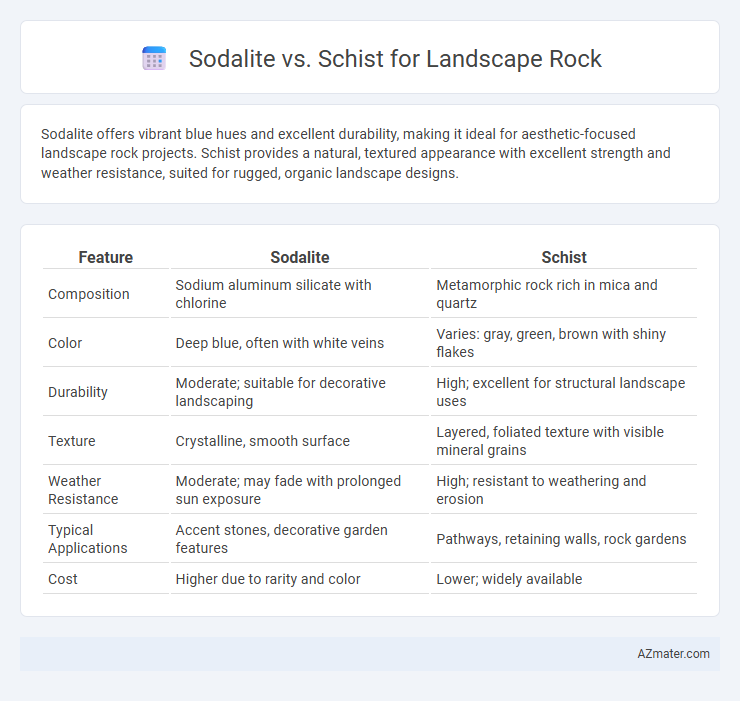Sodalite offers vibrant blue hues and excellent durability, making it ideal for aesthetic-focused landscape rock projects. Schist provides a natural, textured appearance with excellent strength and weather resistance, suited for rugged, organic landscape designs.
Table of Comparison
| Feature | Sodalite | Schist |
|---|---|---|
| Composition | Sodium aluminum silicate with chlorine | Metamorphic rock rich in mica and quartz |
| Color | Deep blue, often with white veins | Varies: gray, green, brown with shiny flakes |
| Durability | Moderate; suitable for decorative landscaping | High; excellent for structural landscape uses |
| Texture | Crystalline, smooth surface | Layered, foliated texture with visible mineral grains |
| Weather Resistance | Moderate; may fade with prolonged sun exposure | High; resistant to weathering and erosion |
| Typical Applications | Accent stones, decorative garden features | Pathways, retaining walls, rock gardens |
| Cost | Higher due to rarity and color | Lower; widely available |
Introduction to Sodalite and Schist
Sodalite is a vibrant blue, sodium-rich volcanic rock prized for its striking color and rarity, often used in decorative landscaping to add bold visual appeal. Schist is a foliated metamorphic rock characterized by its layered texture and varied mineral content, commonly utilized in landscape design for its natural durability and earthy tones. Both rocks offer distinct aesthetic and functional qualities, making them popular choices for garden paths, rock gardens, and retaining walls.
Geological Origins and Composition
Sodalite, a deep blue tectosilicate mineral, originates primarily from igneous rocks such as nepheline syenites rich in sodium and aluminum, exhibiting a crystalline structure composed mainly of sodium aluminum silicate with chlorine. Schist, a metamorphic rock formed under high pressure and temperature from shale or mudstone, contains abundant mica minerals like biotite or muscovite, giving it a foliated texture with significant quartz and feldspar content. Understanding these geological origins and compositions is essential for selecting landscape rock based on durability, color, and texture preferences.
Visual Differences: Color and Texture
Sodalite features a rich blue color often interspersed with white calcite veins, creating a striking, vivid contrast that enhances landscape aesthetics. Schist displays a more varied palette ranging from gray to brown, with a flaky, layered texture resulting from its metamorphic mineral alignment. The smooth, glassy surfaces of sodalite differ distinctly from schist's rough, foliated appearance, making color and texture primary visual differentiators in landscape applications.
Durability and Weather Resistance
Sodalite offers moderate durability and tends to resist weathering well in dry climates but may show wear in freeze-thaw conditions, making it less ideal for regions with harsh winters. Schist, known for its foliated texture, generally has lower durability due to its layered structure, which can weaken under weather exposure and lead to flaking or erosion over time. For landscape rock in areas with significant moisture or temperature variability, sodalite is typically the more weather-resistant option, while schist requires more maintenance to preserve its appearance and integrity.
Cost Comparison and Value
Sodalite typically costs more than schist due to its vibrant blue hues and rarity, making it a premium choice for landscape rock. Schist offers excellent value with its abundant availability and diverse color patterns, providing a cost-effective option for large-scale landscaping projects. When considering long-term aesthetics and durability, sodalite's unique appearance may justify the higher initial investment compared to the more economical and versatile schist.
Applications in Landscape Design
Sodalite's deep blue color and striking white veins make it ideal for accent pieces, garden borders, and decorative boulders in landscape design, enhancing aesthetic appeal in modern and Mediterranean-themed gardens. Schist's foliated texture and natural shimmer provide excellent ground cover and retaining wall material, supporting erosion control and creating visually dynamic pathways and terraces. Both rocks offer durability and weather resistance, but sodalite is preferred for focal points due to its unique coloration, while schist excels in structural and functional landscaping elements.
Environmental Impact and Sustainability
Sodalite is a less commonly quarried mineral with minimal environmental disruption due to its limited extraction, whereas schist is widely available but often involves more extensive mining operations that can lead to habitat disturbance and increased carbon emissions. Schist's natural durability and widespread availability make it a cost-effective choice, but its environmental footprint depends heavily on responsible sourcing and processing practices. Selecting locally sourced, sustainably quarried sodalite or schist reduces transportation emissions and supports eco-friendly landscape design.
Maintenance Requirements
Sodalite offers low maintenance due to its hardness and resistance to weathering, making it ideal for landscape rock that requires minimal upkeep. Schist, while visually appealing with its distinctive layering, tends to fracture and erode more quickly, necessitating frequent cleaning and occasional replacement. Choosing sodalite minimizes long-term maintenance efforts and preserves landscape aesthetics with less intervention.
Availability and Sourcing
Sodalite is less commonly available as landscaping rock and is typically sourced from specific regions like Brazil, Canada, and Namibia, making it more exclusive and potentially costly. Schist, being a more abundant metamorphic rock found worldwide, is easier to source and often more affordable for large-scale landscaping projects. Availability of Schist in various colors and textures offers versatility, while Sodalite's rarity lends a unique aesthetic value to the landscape.
Choosing the Right Stone for Your Landscape
Sodalite, known for its striking deep blue color with white veins, adds a vibrant visual accent to landscapes while providing durability and resistance to weathering. Schist, characterized by its layered texture and earthy tones, offers excellent drainage and a natural, rustic appearance ideal for garden paths and retaining walls. Selecting between sodalite and schist depends on the desired aesthetic impact and functional requirements, with sodalite suited for bold, decorative features and schist for structural, permeable applications in your landscape design.

Infographic: Sodalite vs Schist for Landscape Rock
 azmater.com
azmater.com